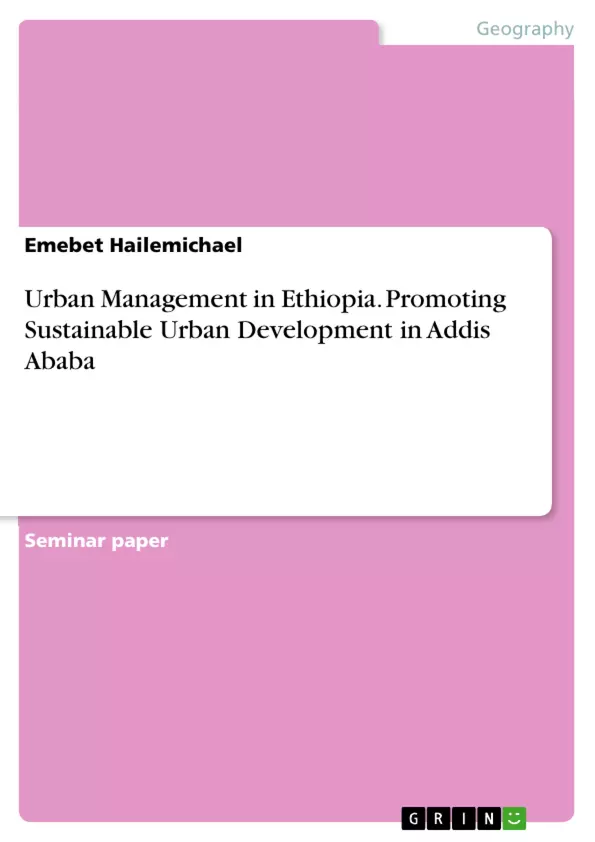The paper presents the application of tools of urban management to promote sustainable urban development in Addis Ababa, Ethiopia.
The city of Addis Ababa was founded in 1886. Addis Ababa is located at the southern foot of Mount Entoto, in the Entoto Mountains, at an elevation of about 8000 feet above sea level, on a plateau that is crossed by numerous streams and surrounded by hills and mountains, in the geographic center of the country.
According to New World of Encyclopedia the city possesses a complex mix of highland climate zones. In addition, the physical structure of the city seems not well planned, and many settlements in many parts of the city are haphazard. With this regard Tolon stated that today’s high-rise apartment and office blocks dot the fronts of the main streets in Addis Ababa, giving a rather misleading impression of a well-built, spacious city. Together with a mixed or apparently well-integrated residential structure, these impressive roadside buildings often effectively mask the predominantly low standards of most housing units and residential neighborhoods.
Inhaltsverzeichnis (Table of Contents)
- 1. Introduction
- 1.1 Background of Addis Ababa
- 1.1.1 Physical Context of Addis Ababa
- 1.1.2 Socio-Economic Context of Addis Ababa
- 1.1.3 Politico-Administrative Context of Addis Ababa
- 1.1 Background of Addis Ababa
- 2. Major Issues of Urban Development in Addis Ababa
- 3. Vision
- 4. SWOT Analysis
- 4.1 Strength of the City
- 4.2 Weaknesses of the City
- 4.3 Opportunities
- 4.4 Threats
- 5. Objectives
- 6. Strategies
- 7. Urban Actors and Stakeholders
Zielsetzung und Themenschwerpunkte (Objectives and Key Themes)
This work aims to analyze the application of urban management tools to promote sustainable urban development in Addis Ababa, Ethiopia. It examines the city's background, challenges, and potential solutions within the context of its unique socio-economic and political landscape.
- Sustainable urban development in Addis Ababa
- Challenges of rapid population growth and urbanization
- The role of urban management strategies
- Socio-economic disparities within Addis Ababa
- The impact of political and administrative structures
Zusammenfassung der Kapitel (Chapter Summaries)
1. Introduction: This chapter provides a foundational overview of Addis Ababa, encompassing its physical, socio-economic, and politico-administrative contexts. The physical context details the city's geography, climate, and somewhat haphazard urban planning, contrasting impressive main streets with the predominantly low standards of many housing units. The socio-economic context highlights the stark disparities between the higher, middle, and lower socio-economic classes, with the lower class facing significant challenges in access to basic services and living in often-deteriorated conditions. Finally, the politico-administrative context explains Ethiopia's three-tier government structure and Addis Ababa's unique dual role as both a federal capital and an autonomous administration, creating complexities in roles and responsibilities.
2. Major Issues of Urban Development in Addis Ababa: This chapter identifies key challenges hindering Addis Ababa's urban development. Rapid population growth, driven by both natural increase and migration, is highlighted as a major concern. The resulting strain on infrastructure, housing, and essential services like education, healthcare, and sanitation is emphasized, illustrating how these issues divert resources from broader development initiatives and significantly hamper progress.
Schlüsselwörter (Keywords)
Sustainable urban development, Addis Ababa, urbanization, rapid population growth, urban management, socio-economic disparities, politico-administrative context, informal settlements, infrastructure, service delivery, migration.
Frequently Asked Questions: Addis Ababa Urban Development
What is the purpose of this document?
This document provides a comprehensive preview of a work analyzing the application of urban management tools to promote sustainable urban development in Addis Ababa, Ethiopia. It includes a table of contents, objectives and key themes, chapter summaries, and keywords.
What topics are covered in the document?
The document covers various aspects of urban development in Addis Ababa, including its physical, socio-economic, and politico-administrative contexts; major issues like rapid population growth and its impact on infrastructure and services; the city's strengths, weaknesses, opportunities, and threats (SWOT analysis); objectives and strategies for sustainable urban development; and the roles of various urban actors and stakeholders.
What are the key challenges facing Addis Ababa's urban development?
Key challenges include rapid population growth (both natural increase and migration), straining infrastructure, housing, and essential services (education, healthcare, sanitation). Socio-economic disparities are also significant, with lower socio-economic classes facing considerable challenges in accessing basic services and living in often deteriorated conditions. The document also notes complexities arising from Addis Ababa's dual role as a federal capital and an autonomous administration.
What is the document's approach to analyzing Addis Ababa's urban development?
The document utilizes a structured approach, examining the city's background, current challenges, and potential solutions within its unique socio-economic and political context. It employs tools like SWOT analysis to assess the city's situation comprehensively.
What are the key themes explored in the document?
Key themes include sustainable urban development in Addis Ababa, challenges of rapid population growth and urbanization, the role of urban management strategies, socio-economic disparities within the city, and the impact of political and administrative structures.
What is the structure of the document?
The document is structured into chapters, beginning with an introduction providing context on Addis Ababa. Subsequent chapters address major urban development issues, vision, SWOT analysis, objectives, strategies, and the roles of urban actors and stakeholders.
What are some of the keywords associated with this document?
Keywords include sustainable urban development, Addis Ababa, urbanization, rapid population growth, urban management, socio-economic disparities, politico-administrative context, informal settlements, infrastructure, and service delivery.
What kind of audience is this document intended for?
The document is intended for academic use, facilitating the analysis of themes related to urban development in Addis Ababa. The structured format and comprehensive overview suggest an audience interested in research and policy analysis.
- Quote paper
- Emebet Hailemichael (Author), 2018, Urban Management in Ethiopia. Promoting Sustainable Urban Development in Addis Ababa, Munich, GRIN Verlag, https://www.grin.com/document/915416



